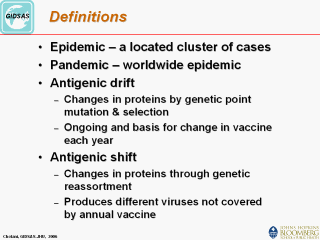| front |1 |2 |3 |4 |5 |6 |7 |8 |9 |10 |11 |12 |13 |14 |15 |16 |17 |18 |19 |20 |21 |22 |23 |24 |25 |26 |27 |28 |29 |30 |31 |32 |33 |34 |35 |36 |37 |38 |39 |40 |41 |42 |43 |44 |45 |46 |47 |review |
 |
Antigenic Shift: Antigenic shift is the process by which two different strains of influenza combine to form a new subtype having a mixture of the surface antigens of the two original strains. The term antigenic shift is specific to the influenza literature; in other viral systems, the same process is called reassortment or viral shift. Antigenic shift occurs only in influenza A because it infects more than just humans. Affected species include other mammals and birds, giving influenza A the opportunity for a major reorganization of surface antigens. Antigenic Drift: Antigenic drift is the natural mutation over time of known strains of influenza to evade the immune system. Antigenic drift occurs in all types of influenza including influenza A, B and C. |